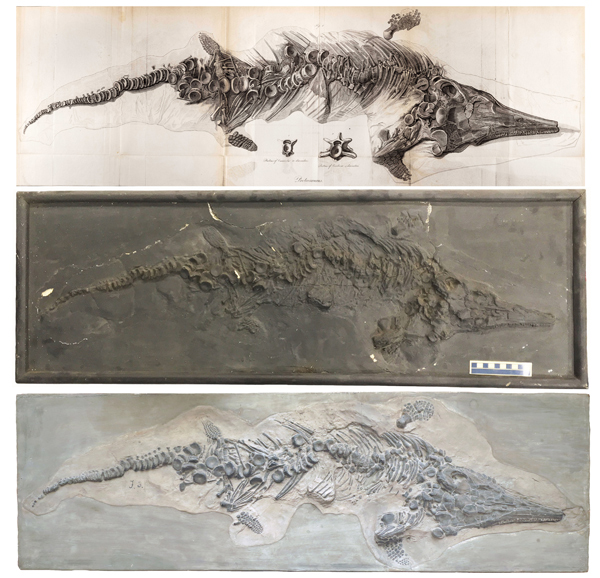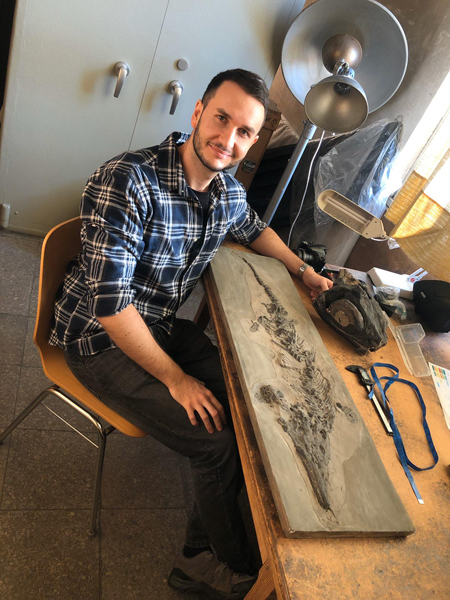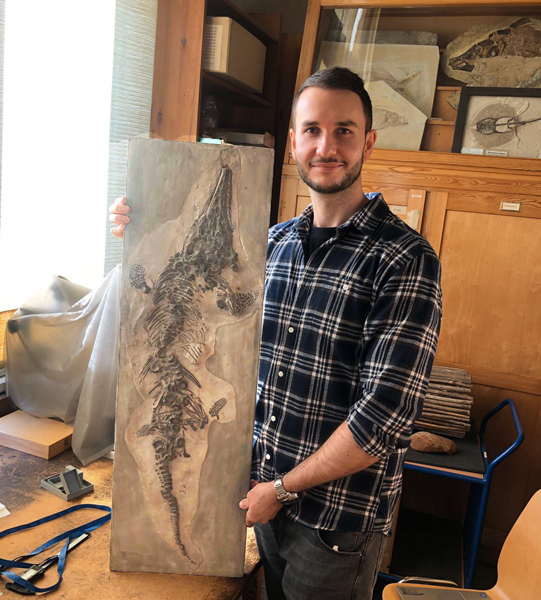A world’s first complete fossil skeleton of a prehistoric reptile studied by scientists that was thought lost forever, has been re-discovered as researchers uncovered marine reptile casts. These casts, although replica copies of the actual fossils, can still provide palaeontologists with valuable information.

“Proteosaurus” Resurfaces
The fossilised remains of an ichthyosaur that was probably excavated by Mary Anning and named “Proteosaurus”, was destroyed in a German bombing raid in World War II. It had been assumed that this historically significant fossil had been lost to science, however, palaeontologists have identified two plaster casts held in collections outside of the UK, which reveal important new data. The casts were discovered by Dr Dean Lomax, a palaeontologist and Visiting Scientist at the University of Manchester, and Professor Judy Massare, from the State University of New York, Brockport, USA.
Dr Lomax in collaboration with renowned palaeoartist Bob Nicholls recently produced a book which looks at the astonishing direct evidence indicating the lives and behaviours of long-extinct animals that can be found in the fossil record. The book entitled “Locked in Time” can be found here (search on the website for author Dean Lomax): Columbia University Press.
Found in 1818
The ichthyosaur fossil was discovered in 1818 at Lyme Regis, Dorset, and almost certainly found by the famous pioneering palaeontologist Mary Anning. Named “Proteosaurus” the specimen was acquired by a prolific collector, Lt-Col. Thomas James Birch, who sold it to the Royal College of Surgeons, London in 1820, to raise funds for Mary Anning and her family who were struggling to pay their rent.
The fossil discovery came at a time when academics were beginning to scientifically study prehistoric animal remains, the sciences of geology and palaeontology were developing. Ichthyosaur fossils had been found earlier, but there was disagreement as to what the specimens represented. Each new fossil find was adding important information to the debate and the 1818 specimen was the most complete ichthyosaur skeleton found to date. It was examined by Sir Everard Home, a highly respected British surgeon, who published his findings in the journal of The Royal Society in 1819.
Unfortunately, the fossil was completely destroyed by a German air raid in May 1941, when the Royal College of Surgeons in London was bombed.

An Important Role in Establishing Palaeontology as a Scientific Discipline
Dr Dean Lomax commented:
“When research on this fossil was published, it was still more than twenty years before the word “dinosaur” would be invented. This and other early ichthyosaur finds sparked a major interest in collecting more of these curious, enigmatic creatures. The discoveries and research on ichthyosaurs played an important role in establishing palaeontology as a scientific discipline.”
Dr Lomax and Professor Massare have collaborated on numerous projects and have made several important discoveries whilst studying historic fossil collections. For example, in 2015, their research led to the naming of Ichthyosaurus anningae, the first, new Ichthyosaurus species to be named in nearly 130 years.
To read more about I. anningae: New Ichthyosaurus Species Named Honouring Mary Anning.
Discovery at the Peabody Museum
In 2016, whilst examining the marine reptile collection housed at the Peabody Museum (Yale University), Massare and Lomax found an extremely old replica cast of an ichthyosaur, which was subsequently identified as the first-known cast of the fossil studied by Sir Everard Home. Up until this point, there was no record of any casts of this significant ichthyosaur fossil.
The Museum Assistant in vertebrate palaeontology at the Peabody Museum, Daniel Brinkman explained:
“Peabody curatorial staff assumed that the specimen was a real ichthyosaur fossil and not a plaster cast painted to look like the original fossil from which it was moulded.”
The Yale University cast was purchased by Yale Professor Charles Schuchert, as part of a substantial collection of fossils from the estate of Frederick A. Braun, a professional fossil dealer, however, very little else is known about the cast. It is not known when Braun acquired it, or who made the cast.
The Berlin Discovery
In 2019, Dean Lomax visited the Natural History Museum in Berlin (Germany) to study their fossil collection and was surprised to find a second cast of the 1818 ichthyosaur. This replica was in much better condition than the Yale cast.
The scientific head of collections at the Natural History Museum (Berlin), Dr Daniela Schwarz commented:
“When Dr Lomax visited our collections, he kept asking me for information about this cast and I couldn’t help him very much because of missing records and labelling of the specimen. So, when I learned about the outcome of his detective work and that this important specimen’s cast now rested in our collections for more than a century, I was really stunned! This discovery once more demonstrates the necessity to carefully preserve also undetermined and casted material in a natural history collection for centuries, because in the end, there will always be someone who discovers its scientific value!”

Studying the Ichthyosaur Fossil Replicas
Studies of both casts have shown that they were made at two different times. The Yale cast might even be a very old cast made when the ichthyosaur was still in the possession of Lt-Col. Thomas James Birch.
Professor Massare said:
“In Home’s 1819 article, he illustrated the original skeleton. This drawing by William Clift was the only visual evidence we had of the ichthyosaur. Now, having two casts, we can verify the reliability of the original illustration by comparison with the casts. We have identified a couple of bones that Home missed, and found a few discrepancies between the drawing and the casts.”
This new study has been published today in the journal, Royal Society Open Science, one of the journals of The Royal Society, which ironically published the original paper on the discovery of the ichthyosaur fossil back in 1819.
Explaining the decision to publish in Royal Society Open Science, Dr Lomax stated:
“When we discovered the casts, we felt compelled to submit our research to The Royal Society, especially because they had played a major role in publishing the first accounts of ichthyosaurs in the scientific literature over two hundred years ago.”
Professor Massare added:
“We hope that our discovery of these two casts might encourage curators and researchers to take a closer look at old casts in museum collections.”
Everything Dinosaur acknowledges the assistance of a media release from the University of Manchester.
The scientific paper: “Rediscovery of two casts of the historically important ‘Proteo-saurus’, the first complete ichthyosaur skeleton” by D. R. Lomax and J. A. Massare published in Royal Society Open Science.






Leave A Comment